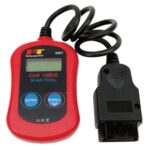Understanding your 2012 Jeep Liberty’s onboard diagnostics system is crucial for modern vehicle maintenance and repair. OBDII (On-Board Diagnostics II) is a standardized system that provides access to a wealth of data about your vehicle’s performance and health. This article will delve into accessing and interpreting OBDII data on your 2012 Jeep Liberty, helping you make informed decisions about your vehicle’s care.
OBDII and Your 2012 Jeep Liberty: What You Need to Know
For vehicles sold in the United States, OBDII became mandatory for all cars and light trucks starting in 1996. This standardization means that your 2012 Jeep Liberty is definitely OBDII compliant. You can typically confirm this by looking for an “OBDII compliant” sticker under the hood. This compliance is excellent news because it allows you to use a wide range of readily available and affordable OBDII scan tools to communicate with your vehicle’s computer.
The primary purpose of OBDII is emissions monitoring, but it has evolved into a comprehensive system for diagnosing various vehicle issues. When your “check engine light” illuminates, it’s often an OBDII code signaling a problem. These codes, along with live data streams from various sensors, can provide valuable insights into what’s happening under the hood.
Accessing OBDII Data on Your 2012 Jeep Liberty
To access this data, you’ll need an OBDII scan tool or code reader. These tools connect to the OBDII port, which is typically located under the dashboard on the driver’s side of your Jeep Liberty. Once connected, the scan tool can communicate with your vehicle’s Powertrain Control Module (PCM) and other modules to retrieve diagnostic trouble codes (DTCs) and live data.
There are different types of OBDII tools available, ranging from basic code readers to advanced professional-grade scanners. The right tool for you will depend on your needs and technical expertise.
Basic OBDII Code Readers
These are entry-level tools that are primarily designed to read and clear generic OBDII fault codes. They are often affordable and easy to use, making them suitable for DIY car owners who want to diagnose simple issues or understand why their check engine light is on. Some basic readers may also display limited live data, offering a snapshot of sensor readings.
One example mentioned in online forums is the AutoLink AL319. This tool is praised for providing straightforward pass/fail results related to the emission system, which can be helpful for quick assessments.
Advanced OBDII Scanners
Moving up the scale, advanced OBDII scanners offer more comprehensive capabilities. These scanners can typically:
- Read and clear generic OBDII codes as well as manufacturer-specific codes, like those from Chrysler (Jeep’s parent company). This is crucial because manufacturer-specific codes can provide more detailed information about problems unique to Jeep vehicles.
- Display extensive live data streams from various vehicle systems, not just the PCM. This can include data from the ABS (Anti-lock Braking System), SRS (Supplemental Restraint System – airbags), and other modules. Accessing live data allows you to monitor sensor readings in real-time, which is invaluable for diagnosing intermittent issues or understanding system behavior under different conditions.
- Offer bi-directional control in some cases. This advanced feature allows you to send commands to the vehicle’s modules to perform tests or activate components. Bi-directional control is generally found in more professional-grade scanners.
Examples of scanners discussed by Jeep owners include:
- Autel Scanners (like the Diaglink or MD802 series): These are popular choices as they often provide a good balance of features and affordability. They are known for their ability to read both generic OBDII and manufacturer-specific Chrysler codes. Some models also allow for software upgrades to expand their capabilities for other vehicle brands.
- Innova 3160d (and newer versions): This is another well-regarded mid-range scanner favored by DIYers and mechanics. It’s praised for reading ABS and airbag data in addition to powertrain information and offering features like live data recording and playback.
- Autel MaxSys MS906BT (and higher-end models): These represent professional-grade scanners. They offer extensive functionality, including comprehensive live data, bi-directional controls, and advanced functions like system resets (e.g., steering angle sensor, oil change reminders). While more expensive, these tools provide the depth of diagnostics needed for professional mechanics.
Choosing the Right OBDII Tool for Your 2012 Jeep Liberty
The best OBDII tool for your 2012 Jeep Liberty depends on your intended use:
- For basic check engine light diagnosis and code clearing: A basic OBDII code reader may suffice.
- For more in-depth DIY diagnostics, including ABS, airbag, and manufacturer-specific codes: A mid-range scanner like the Innova 3160d or Autel Diaglink would be a worthwhile investment.
- For professional mechanics requiring comprehensive diagnostics and bi-directional control: A high-end scanner like the Autel MaxSys series or similar professional-grade tools are necessary.
It’s important to consider your budget and technical comfort level when choosing a scanner. For most 2012 Jeep Liberty owners, a mid-range scanner provides an excellent balance of features and usability for effective vehicle diagnostics and maintenance. Investing in a good OBDII scanner empowers you to understand your vehicle better, potentially saving money on diagnostic fees and enabling you to perform more repairs yourself.

